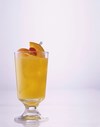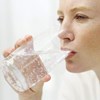Posted 4/9/2010
by Roseann Doran

It seems that everywhere you look these days – on television, at the grocery store, vending machines, and sporting events – you see claims made about the benefits of energy drinks. But are these caffeine-laden beverages really providing energy, improved performance, or mental alertness as many of them claim? Let’s take a look.
Depending on the brand, energy drinks contain mostly carbonated water in combination with caffeine and a host of other ingredients and flavorings, which can include sugar, ginseng, taurine, carnitine, guarana, and one or more added vitamins.
Posted 4/7/2010
by Roseann Doran

Should you drink a sports drink if you engage in regular physical activity?
Sports drinks are popular, you see them at the gym, in vending machines, and at convenience stores. Sports drinks contain flavorings, carbohydrate (usually in the form of high fructose corn sweetener) and electrolytes. They are formulated to replace fluids, electrolytes and carbohydrates during times of intense activity. The carbohydrate in sports drinks provides energy to working muscles so that activity can continue. Sports drinks are flavored which encourages consumption so the athlete can fully rehydrate. There is ample research to suggest that athletes participating in competition, workouts or training for 60 minutes or longer and/or in hot climates or at high altitudes benefit from sports drinks.
What about after your nightly workout or afternoon mowing the grass? Do you need sports drinks to stay hydrated?
Since the early days of Gatorade, sports drinks have moved from the locker room to the mainstream. Today athletes and non-athletes drink sports drinks. There is no evidence to support the use of sports drinks for athletic events or bouts of physical exertion of less than 60 minutes. Certainly, sports drinks are not appropriate for those not engaged in athletics or manual labor. At about 100 calories for 16 ounces, sports drinks do have less sugar and calories than other soft drinks. However, they still contain substantial calories and no redeeming nutritional qualities. In other words, for the non-athlete, they are not much better than drinking soft drinks. There are several sports drinks on the market that are sweetened with artificial sweetener or contain less caloric-sweetener than regular sports drinks. These may be good alternatives for athletes who want to watch their calorie intake.
Source: Are Sports Drinks a Good Beverage Choice?, www.extension.org
Posted 4/7/2010
by Roseann Doran

Sometimes people switch from drinking soda or soft drinks to drinking fruit juice in an effort to control their weight. Surprisingly, ounce for ounce, 100% fruit juice may contain more calories than soda or soft drinks. This means that drinking the same amount of juice instead of soda or soft drinks could actually contribute to weight gain! At the very best, switching from soft drinks to juice is not helping with calorie control.
Another issue is that fruit juices are often confused with sweetened beverages that contain little or no real juice. Watch out for beverages that are labeled as “fruit punches," "juice drinks," or "juice cocktails.” Always look for the word “juice” all by itself or “100% juice.” Fruit juice should be the first ingredient listed on the ingredients list. Avoid fruit beverages that contain sugar, corn syrup, or other sweeteners.
While 100% fruit and vegetable juice contain vitamins, minerals, and antioxidants, it is best to eat whole fruits and vegetables as opposed to juice. Juice lacks the fiber that whole fruit contains. If you do consume juice, make sure it is 100% fruit or vegetable juice, and consume it in small amounts. An adult serving size for fruit juice is 4 to 6 fluid ounces, not the 20-ounce bottle you see in vending machines and convenience stores.
Source: Is Juice a Good Substitute for Soft Drinks? Last Updated: November 18, 2009
Posted 4/2/2010
by Roseann Doran

Drinking water is the No. 1 strategy to rethink your drink. It is the perfect beverage – it is calorie-free, sugar-free, fat-free, and almost free (if you drink tap water).
Try these strategies to make water Number One:
- Keep water and other calorie-free beverages on hand at work, at home, and in the car. Make it easy for everyone to choose water.
- Don’t keep sugar-sweetened beverages at home or work. We tend to drink what is available, so make your home and office sugar-free.
- Carry a water bottle with you and refill it throughout the day.
- Add a slice of lemon, lime, or orange to jazz up your water. Make a pitcher of water with fruit slices and keep it in the refrigerator.
- Add a splash of fruit juice to still or sparkling water.
Source: Make Water Your Number 1 Beverage, www.extension.org
Posted 3/22/2010
by Roseann Doran

National Nutrition Month ® is sponsored annually each March by the American Dietetic Association. The theme this year is Nutrition From the Ground Up.
The campaign focuses attention on the importance of making informed food choices and developing sound eating and physical activity habits.
The nutrient-rich-foods way of eating emphasizes choosing foods based on their total nutrient package, including vitamins and minerals, instead of choosing foods based only on what they don’t contain – saturated fat, sugar and salt. It offers a positive foundation to help build overall healthier eating habits and meet nutrition needs over a lifetime.
Choosing nutrient-rich foods first is a positive and realistic way to think about eating and focuses on enjoying food instead of avoiding it. Selecting nutrient-rich foods and beverages first is a way to make better choices within your daily eating plan.
Posted 3/19/2010
by Roseann Doran

Quick meals are a necessity, especially when time is limited by working outside the home, participating in many community activities, or staying busy with small children or elderly parents. Throwing together a meal in minutes is easy if you have done some advance preparation.
Forty-five years ago a typical family meal took 2½ hours to prepare. Today it takes only 45 minutes or less to have a meal on the table, yet 60% of American women would like to shorten that time to 15 minutes or less!
Posted 3/16/2010
by Roseann Doran

The two keys to making quick, healthy meals and snacks are to keep a well-stocked kitchen and to spend a few minutes planning meals every week.
Buy foods you can make and serve in a hurry. Look for items that are low-sodium (salt), fat-free or low-fat, and choose canned fruit packed in water or juice. Stock your pantry with healthy snack items, such as dried fruits, whole grain crackers and nuts. Serve goodies only on special occasions. Don’t tempt your family with chips, cookies, candy, soft drinks and other junk foods.
Here is a basic list of versatile staple foods to stock in your pantry, refrigerator and freezer. The list can be personalized based on the foods your family likes and uses often.
Posted 3/10/2010
by Roseann Doran
Many of today’s children and adults are part of a generation that has grown up in restaurants and fast food eateries. Preparing and eating meals at home is a better choice for many reasons.
- It is usually healthier and tastes better, because the cook has control over the ingredients in meals cooked at home.
- It helps to better control the amounts of food served, or the portion sizes.
- It allows for more family time. Teens and children can learn to prepare and serve meals.
- It is generally cheaper than eating out.
Posted 3/4/2010
by Roseann Doran

Among those who suffer from allergies or sensitivities to specific foods, one of the more challenging food sensitivities is intolerance to gluten. Gluten is a combination of two proteins, gliadin and glutenin, found in certain grains (including wheat, barley, rye and oats). Gluten's function is to form a sticky protein that provides the elasticity and structure to baked breads. It is the gliadin portion in gluten that elicits the allergic response, which varies in severity and manifestation of symptoms in those with this condition. The only treatment is complete removal of gluten from the diet, something that can be nearly impossible to achieve.
Posted 3/1/2010
by Jennifer Martin via Roseann Doran

USDA has joined the National Collaborative on Childhood Obesity Research (NCCOR), a public-private research collaboration to accelerate progress on preventing and reversing the childhood obesity epidemic. The National Institutes of Health (NIH), the Centers for Disease Control and Prevention (CDC) and the Robert Wood Johnson Foundation (RWJF) launched NCCOR in February 2009.
"As a leader in studying the role of foods and nutrition in childhood obesity, USDA can strengthen this collaboration and add valuable knowledge and considerable resources to combat this epidemic," Vilsack said. "USDA welcomes this important opportunity for a dynamic research partnership that exemplifies President Obama's vision of federal and non-profit leaders working together to improve the health of all Americans."
















